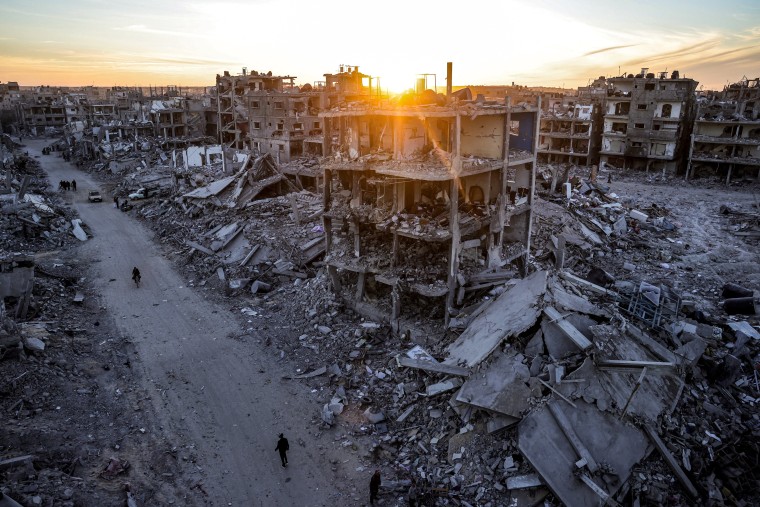The six-week ceasefire in Gaza expired Saturday, with Hamas accusing Israel of “evading the commitment to end the war and withdraw completely from Gaza.”
“There are no negotiations” regarding the second phase, Hamas spokesperson Hazem Qassem told Al-Araby TV on Saturday, adding that Israel’s proposal to extend the first phase “is unacceptable to us."
Later on Saturday evening, the office of Prime Minister Benjamin Netanyahu said Israel will adopt a plan by U.S. special envoy to the Middle East Steve Witkoff that would extend the temporary ceasefire through Ramadan and Passover, which conclude at the end of March and on April 20, respectively.
Under the proposal, half of the remaining hostages, including bodies of those who have died, would be released on day one of its execution, with the rest released upon successful negotiation of a permanent ceasefire, according to Netanyahu's office. Israel’s move to adopt the plan was made during an overnight security meeting, it said.
If a more permanent deal is out of reach on the 42nd day of peace negotiations, Israel can return to fighting, Netanyahu’s office said. That provision, it said, is supported by the Trump administration.
The White House did not immediately reply to a request for comment.
Hamas has yet to accept the proposal and did not immediately respond to a request for comment on the statement from Netanyahu’s office. Separately, Israel has not confirmed the latest developments in its negotiations with Hamas and also did not respond to a request for comment.
Israel said it would immediately begin negotiating on the details of the plan if Hamas changes its stance.
Talks on the second phase were set to begin weeks ago. In January, during the initial announcement of the agreement, then-President Joe Biden said the ceasefire would continue even after six weeks “as long as the negotiations continue.”

The second phase of the ceasefire would have seen the release of additional hostages and prisoners, mark the withdrawal of Israeli forces from Gaza, and ultimately lead to a permanent end to the war.
Hamas has retained 27 hostages who are still alive and more than 30 who are believed to be dead, according to an NBC News tally.
The U.S., Egypt and Qatar — the three countries that helped mediate the deal — continue to act as guarantors of the agreement.
Amid concerns around the truce, the Pentagon said Friday that the U.S. State Department had approved the potential sale of nearly $3 billion worth of bombs and other weaponry to Israel on an emergency basis. The sale marked the second time the Trump administration declared an emergency to approve weapons sales to Israel since last month.
The fragile ceasefire agreement, which came into effect on Jan. 19, halted months of fighting and allowed the exchange of 33 Israeli and five Thai hostages for nearly 2,000 Palestinian prisoners and detainees.
Under the agreement, Israeli forces were due to withdraw from the Philadelphi Corridor on Saturday, a provision that has remained a major sticking point in the ceasefire negotiations.
Israel earlier said it would not allow Hamas to take over the corridor.
“We will not withdraw from the Philadelphi Corridor. We will not allow Hamas murderers to roam our borders again with trucks and rifles, and we will not let them rearm through smuggling,” an Israeli official told NBC News on Thursday, referring to the weapons and other materials that entered Gaza over the Egyptian border.
The narrow strip of land that runs along Gaza’s border with Egypt and includes the key Rafah border crossing has also been a lifeline for Palestinians in Gaza — allowing the entry of goods and humanitarian aid in the years before the war.
Another major sticking point is Hamas’ continued presence in Gaza. On Thursday, Basem Naim, a senior Hamas official, told NBC News that the militant group would be willing to cede political and administrative power in the Gaza Strip to a Palestinian unity government, but would not disarm until an independent Palestinian state is achieved.
Naim added that the group was also preparing for renewed fighting. “If they decide to escalate and to return back to war, we are preparing ourselves for all options,” he said.
For now, the situation in the Gaza Strip has remained calm, according to NBC News’ crew on the ground.
Footage from Friday captured Palestinians preparing for Ramadan as children gathered in the rubble-filled streets in Khan Younis to watch adults hang decorations and Palestinian flags beside the ruins of destroyed homes.
Rehan Hazaam Shorab, a 30-year-old mother of two, made paper lanterns out of cardboard boxes from humanitarian aid packages.
“The war has created a psychological state for us. I try to overcome the experiences I lived by working, channeling the negative energy into my work,” she said, adding, “I am worried that the war will resume. It was the worst day of our lives.”
United Nations Secretary-General António Guterres urged Israel and Hamas "to exercise maximum restraint and find a way forward on the next phase" of the ceasefire.
"As Ramadan — a time of peace and reflection — begins, the Secretary-General calls on all sides to spare no efforts to end all violence," a spokesperson for Guterres said on his behalf. "The United Nations stands ready to support all such endeavours."
The Hamas-led terror attack on Oct. 7, 2023, that sparked the war saw about 1,200 people killed and 251 captured, according to Israeli officials.
Israel’s ensuing military offensive in Gaza has killed more than 48,000 Palestinians, according to the local Health Ministry, destroyed much of the enclave, and forcibly displaced most of its population of 2.3 million.